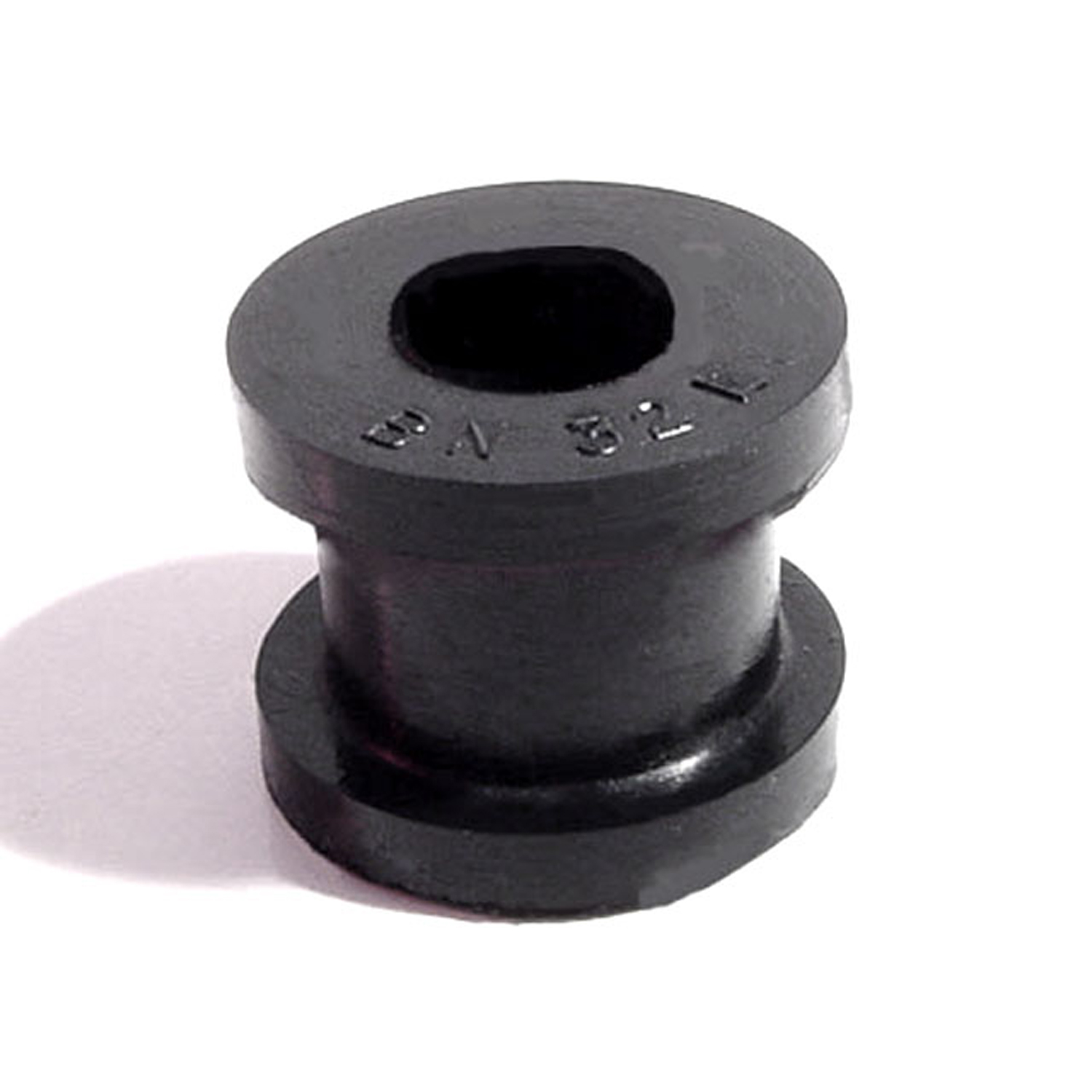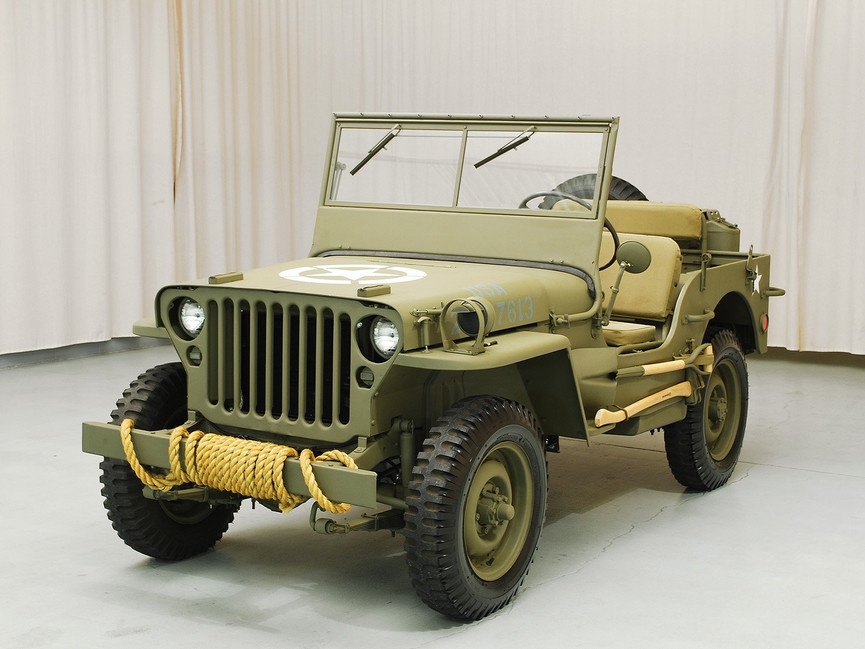Image of 1945 Ford Jeep, sourced from hymanltd.com , Image Link.
Performance Metrics
Fundamental Metrics
Emotional Appeal
MMP Rating
| Engine Specifications | |
|---|---|
| Engine: | L134 Go Devil I4 |
| Displacement: | 134.2 cu in (2.2 L) |
| Horsepower: | 54 hp at 4000 rpm |
| Torque: | 105 lb-ft at 2000 rpm |
| Compression Ratio: | 6.48:1 |
| Ignition System: | 6-volt electrical system |
| Cooling System: | Liquid-cooled |
| Performance Specifications | |
| 0-60 Time: | Not available |
| 1/4 Mile Time: | Not available |
| Top Speed: | 65 mph |
| Transmission and Drive | |
| Drive Type: | 4WD |
| Transmission Type: | 3-speed manual |
| Fuel and Efficiency | |
| Fuel System Type: | Carburetor |
| MPG: | 15 mpg |
| Dimensions and Brakes | |
| Brakes: | Hydraulic drum brakes |
| Wheelbase: | 80 in (203 cm) |
| Weight: | 2400 lbs (1089 kg) |
Note: Specifications for classic cars are given to the best of our ability, considering the limited and variant data available.
A Stalwart of the Second World War: The 1945 Ford Jeep
The 1945 Ford Jeep is a vehicle that not only embodies the rugged determination of wartime engineering but also marks a significant chapter in automotive history. Born out of necessity during the tumultuous times of World War II, this iconic car was manufactured by Ford under the auspices of the Willys-Overland design. Its creation was a direct response to the U.S. military's need for a light reconnaissance vehicle, and it quickly became an integral part of the Allied forces' arsenal.
While its roots are firmly planted in military service, the Ford Jeep's influence extended far beyond the battlefield. It introduced a new level of versatility to motor vehicles, setting a precedent for future four-wheel-drive utility vehicles. A standout moment in its history was its ubiquitous presence during D-Day landings, where it served as a symbol of liberation and resilience.
Design and Innovation: The Quintessence of Functionality
The 1945 Ford Jeep's exterior styling was less about aesthetics and more about function. Its flat fenders, simple round headlights, and slatted grille were designed for ease of manufacturing and maintenance. Inside, the Jeep was Spartan at best, with basic gauges and minimal comfort features – a reflection of its utilitarian purpose. Materials used were durable and rugged, able to withstand the harsh conditions faced on the front lines.
Despite its straightforward design, the Ford Jeep did boast some technological features that were advanced for its time, such as four-wheel drive and a surprisingly capable suspension system. As for color options, the most common was undoubtedly olive drab, although other military colors were used depending on the theater of operation.
The body style was primarily that of an open-top with canvas coverings available for protection against elements. The most iconic version is undoubtedly the Willys MB model with its fold-down windshield and rear-mounted spare tire.
Historical Significance: A Legacy Cast in Steel
The 1945 Ford Jeep's impact on automotive design cannot be overstated. It pioneered off-road capability in production vehicles and laid the groundwork for modern SUVs and crossovers. What set this car apart from others at the time was its remarkable versatility – it could be used as a troop carrier, ambulance, reconnaissance vehicle, or even a makeshift tractor.
Its lasting influence is evident in today's off-road community; many four-wheel-drive systems owe their lineage to innovations first seen on this wartime workhorse.
Performance and Handling: A Testament to Simplicity
Performance-wise, the 1945 Ford Jeep was not built for speed but rather reliability under challenging conditions. Its top speed hovered around 65 mph with acceleration figures largely dependent on terrain rather than time. Handling-wise, it was unmatched off-road; capable of navigating through mud, snow, and sand with relative ease.
Driving one today is an exercise in historical appreciation – from the unmistakable sound of its inline-four engine to the no-frills ride that connects you directly with the road (or lack thereof). It offers an authentic driving experience that modern vehicles can rarely replicate.
Ownership Experience: From Battlefield to Backroad
Originally intended for military use, post-war surplus saw many Jeeps repurposed as farm equipment, construction vehicles, or even daily drivers. Their simple mechanical nature meant they were relatively easy to maintain and repair by average owners. However, parts can be scarce today due to their age and historical value.
Fun Facts: The Jeep's Place in History
A fun fact about these Jeeps is that some were even equipped with special kits for railway track conversion or fitted with flotation devices for amphibious use! While not known for breaking speed records, they certainly set a high bar for versatility. Celebrity ownerships include film stars like Steve McQueen who appreciated their rugged charm.
Common criticisms at the time centered around comfort – or lack thereof – but these were quickly overshadowed by their reliability and capability.
Collector's Information: An Evergreen Classic
Today, a well-preserved 1945 Ford Jeep can fetch anywhere from $15,000 to $30,000 depending on condition and originality; however rare models or those with significant provenance can command much higher prices. Estimates suggest that over 300,000 units were produced during wartime; however exact numbers vary due to shared production between manufacturers like Willys-Overland and Ford.
As collector items, their value has steadily appreciated over time due to their historical significance and popularity among classic military vehicle enthusiasts.
Conclusion: The Indomitable Spirit of Freedom on Four Wheels
The 1945 Ford Jeep stands as more than just a car; it is a testament to ingenuity under pressure and has become an enduring symbol of American resilience. Its legacy is not only etched into military history but also into automotive evolution – influencing designs decades after it first rolled off assembly lines. For collectors and historians alike, it remains an invaluable piece of heritage – forever capturing the spirit of an era defined by courage and innovation.
1945 Ford Jeep Catalog of Parts
 1945 Ford JEEP Generator Support Insulator Bushing. Each-BN 32-EGenerator Support Insulator Bushing. Each
1945 Ford JEEP Generator Support Insulator Bushing. Each-BN 32-EGenerator Support Insulator Bushing. EachWhy Choose Metro?
For over 100 years, Metro Moulded Parts has been the pinnacle of quality in classic car restoration parts. Our commitment to precision and authenticity in every component ensures a perfect fit and an OEM-level appearance.
- Expert Craftsmanship & Quality: Each part is a testament to our dedication to reliability and perfection, crafted from original designs and thoroughly tested.
- Advanced Technology: We use cutting-edge techniques to create flawless, long-lasting parts that surpass others in performance.
- SuperSoft Sponge – The Ultimate Door Seal: Not only are our door seals 30% softer than competitors', but they're also guaranteed to never leak. They effectively reduce wind and road noise, enhancing your classic car's comfort and driving experience.
- Proudly American: Our parts are a product of American craftsmanship, made in the USA with a spirit of excellence and heritage.
- Unrivaled Warranty: We back our products with a 30-year industry-leading warranty, a testament to our confidence in their quality.
Join us in preserving the legacy of classic cars with parts that are crafted for perfection, not just made.

